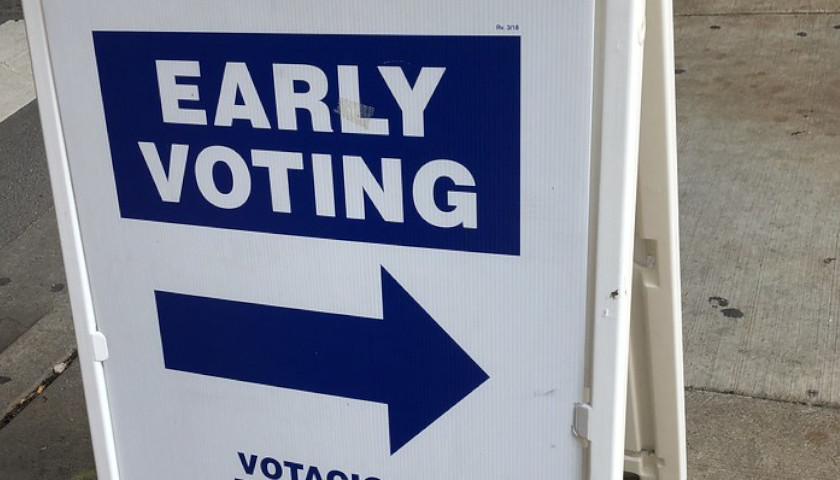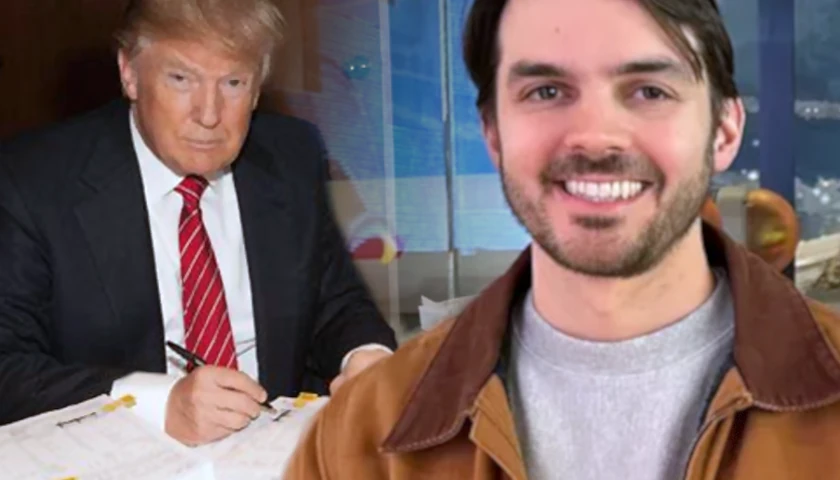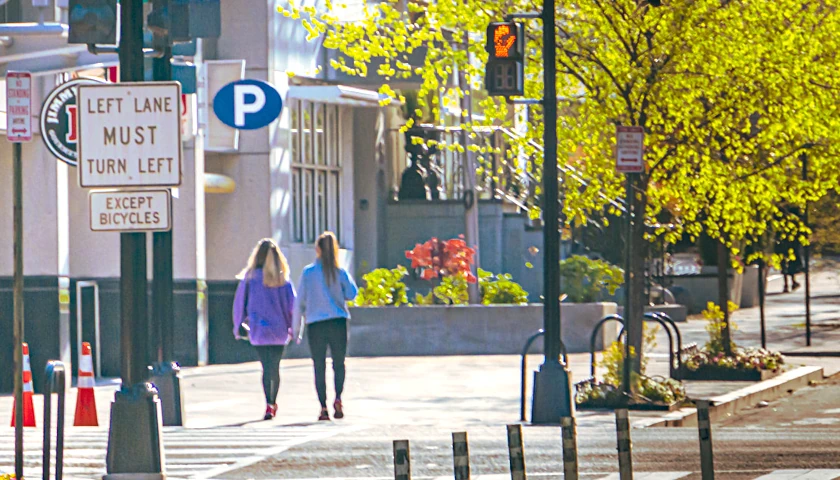by Susan Crabtree
Two days before Brian Kemp bested Stacey Abrams by more than seven percentage points in their closely watched rematch, the Georgia governor did something unusual for a Republican candidate in the 2022 midterms: He expressed confidence about where he stood and cited early voting as a top reason.
“We’ve also had record turnout for early voting, which ended this Friday. It’s been an incredible turnout, and we feel good about things,” Kemp told Trey Gowdy, the former congressman and host of Fox News’ “Sunday Night in America.”
Kemp wasn’t just projecting optimism to sound upbeat on the eve of the election as many candidates on both sides of the aisle often do. He and his team prioritized early voting in their overall strategy to combat the vaunted Abrams’ ground-game machine. Heading into Election Day, Kemp had seen the early voting data rolling in and knew he was in a stronger-than-expected position.
In the end, Kemp received more votes cast through early in-person voting than Abrams, 1.139 million to 1.134 million. The governor also remained competitive with the mail-in vote instead of getting crushed, as most Republicans did this cycle, in this advance form of voting that was greatly expanded during the pandemic. Kemp received 90,080 mail-in votes to Abrams’ 152,494, while overwhelming Abrams with the predicted GOP flood of Election Day votes, 880,246 to Abrams’ 523,654.
The result was a big win for Kemp, as well as impressive turnout across the state. Such high voter participation across nearly all demographics undercuts Democrats’ argument that the Georgia GOP-passed voting laws ushered in a new era of voter suppression, or as President Biden put it, “Jim Crow 2.0.”
Kemp campaign operatives who helped devise and execute his successful campaign strategy attribute the win in part to a deliberate and painstaking effort to focus on early voting and turnout.
“Gov. Brian Kemp’s organization ran a very concerted effort … to target and mobilize during the pre-Election Day period,” said Mark Stephenson, the CEO of Red Oak Strategic, an analytics and data science firm. “We modeled, turned out and tracked voters, specifically low and mid propensity voters, who may not traditionally vote in the midterm and who our models said supported the governor.”
While Abrams had hundreds of supporters knocking on doors for her every day in the final stretch, Kemp’s campaign focused on a data-driven operation specifically designed to compete in early voting.
“Georgia is a great example of a success story,” Stephenson said. “[Kemp] was able to win pre-Election Day in Georgia by 6,000 votes, and then blow out the margins on Election Day proper.”
Although Georgia was the exception for Republican candidates on Nov. 8, rather than the rule, Florida Republicans also outpaced Democrats in early voting and kept a competitive pace with the mail-in votes.
The day before the election, 4.8 million people had already voted in Florida, a third of all registered voters in the state. Republicans outpaced Democrats in early in-person voting by more than 480,000 votes, according to the state Division of Elections, while Democrats had returned about 163,000 more mail-in ballots than Republicans. As of Monday afternoon before Election Day, the Miami-Dade County Elections Department’s data showed that about 30% of voters had cast their ballots, and most were Republicans. The statewide results reflected this push: Sen. Marco Rubio significantly outperformed his pre-election polling and cruised to a 16-point win over Democratic challenger Val Demings, while Gov. Ron DeSantis became the first Republican gubernatorial candidate to win the county in two decades on his way to a landslide victory.
“If you wait ‘til Election Day, you get a flat tire, you can’t take a mulligan,” DeSantis told a packed crowd at a Jewish community center in October.
“We cannot be complacent about this.”
But many Republican candidates outside Florida and Georgia were complacent and the election returns told the tale. A wave of envelopes containing mail-in ballots boosted Democratic candidates to victories in several key Nov. 8 races.
The Pennsylvania Senate race is the prime case in point. Republican Mehmet Oz drew some 500,000 more voters to the polls on Election Day than Democrat John Fetterman. But Fetterman’s mail-in total exceeded 868,000 – quadruple Oz’s early voting total. The result: a lopsided 655,000-vote advantage for Fetterman, who won by 4.6%.
In the aftermath of the election when the expected Republican “red wave” never materialized, GOP officials and activists have variously blamed Donald Trump, their own party leaders, and the Democrats’ advantage in the small-dollar money chase.
Some also have railed against the early voting system benefiting Fetterman before voters could see his Oct. 25 debate with Oz. That debate, the only face-off of the campaign, showed a stammering Fetterman displaying the effects of a stroke he suffered in May. Pennsylvania voting rules are some of the most complicated in the nation, with some counties allowing voters to submit absentee and mail-in ballots 50 days before Election Day.
“They ran a scam in Pennsylvania … because Fetterman hid his health for months while the media covered for him and early votes poured in and [he] refused to debate Oz until the very last week, while he’d already banked thousands of early votes,” Fox News’ Jesse Watters griped a day after the election. “This early voting thing Republicans have to get a handle on. We show up on Election Day, and Democrats show up weeks before Election Day, day after day after day. What’s the Republican strategy on early voting? I don’t know. Do you? … Unless we have a game plan for these mail-in ballots and early voting, this is déjà vu.”
J.D. Vance, one of the few major Trump-endorsed candidates who won, penned an op-ed urging Republicans not to point the finger at the former president for the much anticipated red wave turning into a disappointing ripple. Vance mainly blamed Democrats’ significant fundraising advantage in most races, but he also wrote that Republicans need to work on their turnout machine to compete in states where Democrats have an expanded vote-by-mail system and a baked-in advantage.
In the short-term, in states where Republicans control the legislatures, Vance said they need to continue pushing for voting reforms – things like “establishing fair but narrow windows to return ballots” and implementing signature verification and laws that require rapid tabulation of early votes, as well as photo ID requirements.
Over the long haul, Republicans need to work on building a turnout machine that can compete with Democrats’ reliance on union foot soldiers, he argued. Until that happens, Vance said Trump, who still can mobilize an army of loyalists, can help generate turnout.
Jason Snead, who heads the conservative Honest Elections Project, argues that Republicans need to play by the early voting rules in states even if they don’t like the laws and strongly disagree with them.
“Given that the rules are what they are, if you aren’t playing by the rules, you are conceding an advantage to your opponent,” he told RCP.
Snead compares the decision by California and other states to mail ballots to all registered voters and allow others to harvest them and turn them in for voters to “performance-enhancing drugs.”
“Unless states ban these drugs, then everyone’s got to use them, or they’re just going to constantly be behind,” he said.
The two parties’ divergent approach was evident in Nevada. In October, Trump held a rally for Nevada Republicans, including Adam Laxalt, who narrowly lost his challenge to Democratic Sen. Catherine Cortez Masto. Jim Marchant, who lost his race for secretary of state, was also on hand. In 2020, Marchant ran a failed campaign for Congress and unsuccessfully sued to overturn the result, arguing that he was a victim of fraud.
When Trump introduced Marchant at the rally, the 45th president told the crowd, “You gotta elect this guy – he’s so tough.”
When it was his turn to speak, Marchant declared that he and Trump lost their 2020 elections because the system was “rigged” and pledged to fix it if elected.
Contrast the approach with Nevada Democrats’ laser focus on early voting. Cortez Masto talked about early voting at nearly every campaign stop in the weeks leading up to Election Day. In the final week, she also held an early voting rally with former President Obama. Democrats also have a natural ground-game advantage in Nevada where the powerful Culinary Workers Union, which represents tens of thousands of hospitality workers in Las Vegas and Reno, comes out in force to help with the final get-out-the-vote push.
North Carolina Republican Sen. Thom Tillis faced the political threat of his life in 2020 during the height of the pandemic when his state transitioned to a mostly early voting system. Instead of ceding that ground, Tillis made a concerted effort to push back against GOP distrust of absentee and early voting.
“Absentee voting begins today!” he tweeted in early September. “With so much uncertainty, there isn’t a safer way to vote than by absentee. I’m doing it, and I encourage everyone else to do so as well.”
Tillis ended up defeating Democratic opponent Cal Cunningham by 1.8%, and his absentee voting advocacy helped him stay competitive in the pre-Election Day vote. Cunningham secured more than 167,000 more absentee votes than Tillis, a difference of just 3.6%.
Several veteran Republican operatives contacted by RCP blamed the GOP party committees – the Republican National Committee and the National Republican Senatorial Committee – for failing to prioritize early voting and the ground game as a whole. They groused that the committees spent too much early in the campaign while failing to significantly invest in the final weeks.
The party committees, one GOP consultant said, were counting on donors to continue to invest heavily at the end of the campaign, but sustained inflation hurt the economy, and the money dried up.
At a Republican election night watch party, Nevada Republican Party Chairman Michael McDonald delivered an angry speech about Election Day turning into election week and argued that “the problems” that occurred in 2020 in the Silver State were happening again.
More than a week later, after the dust settled on the Nevada election process, Laxalt lost by roughly 9,500 votes while Clark County Sheriff Joe Lombardo defeated incumbent Gov. Steve Sisolak by nearly 4,000 votes or 1.4%.
In a statement to RCP, McDonald credited the RNC and Chairwoman Ronna McDaniel with building “a machine that helped us turn out voters we needed during the early vote and on Election Day to defeat an incumbent governor for the first time in 40 years.”
“The Nevada Republican Party couldn’t have asked for a better partner to help us deliver Governor-elect Lombardo,” McDonald added. The RNC also defended its early voting outreach record, arguing that McDaniel repeatedly urged GOP voters to cast their ballots early and by absentee.
As part of its ground game, the RNC contacted 83% of registered Republicans who voted early in person, and 78% of registered Republicans who voted through the absentee process, a spokesman told RCP.
Still, one veteran GOP campaign adviser, who requested anonymity, predicted that it would be tough for many Republican candidates to persuade their supporters to trust early voting after Trump and others have sown so much dissent over it. But continuing to operate at a disadvantage in key races is not a winning option. Candidates themselves, not just party officials, need to emphasize the importance of banking their votes early so the campaign can then concentrate on persuading lower-propensity supporters to vote.
“You can’t look at a race like Laxalt’s with him losing by [less than 10,000] votes against an incumbent senator and not think that relying on people to turn in their ballots on Election Day was a mistake,” the veteran campaign adviser said. “It’s just putting too many eggs in one basket.”
– – –
Susan Crabtree is RealClearPolitics’ White House/national political correspondent.
Photo “Early Voting Sign” by Seth Anderson. CC BY-NC-SA 2.0.




